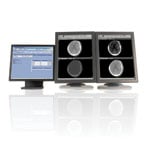
GE Healthcare Centricity PACS
Only the strong and most wired will survive.
This never rang so true for outpatient imaging centers as it does today. With drastic cuts in medical imaging reimbursements, imaging centers must be more nimble than ever. The centers that implement information technology (IT) to leverage interoperability, track business trends, protect data, and enhance patient safety are securing their future.
For the first time, Imaging Technology News invited readers to nominate U.S.-based outpatient imaging centers that have built up their IT infrastructures and qualify them as a “Most Wired Outpatient Imaging Center.”
The four centers featured in this article best met the challenging “Most Wired” criteria.
The “Most Wired” Criteria:
1. Interoperability: The center interfaces with disparate IT systems.
2. Reading tools: The center provides radiologists with IT solutions to manage and read images.
3. Business tools: IT solutions that track trends and support marketing efforts.
4. IT for equipment (safety): IT solutions for safer patient care when using equipment.
RadNet Inc., Calif., N.Y., N.J., Del., Md., Fla. and Kan.
Interoperability: With 175 imaging centers in seven states, RadNet uses several different picture archiving and communication systems (PACS). These PACS include GE Centricity PACS-IW, Philips iSite, Merge Fusion PACS, Chili PACS, and RamSoft PACS. These are all interfaced with two separate radiology information systems (RIS), GE Centricity RIS-IC and Merge Fusion RIS. Their specialty PACS include Thinking Systems PACS for nuclear medicine, Hologic PACS for digital mammography, CadStream, DynaCad, and GE Seno Advantage Workstations for mammography, R2 and iCAD for mammography computer-aided detection (CAD), BABE for obstetric ultrasound, and other specialty systems.
There are more than 450 radiologists that both work for RadNet and practice at hospitals. The hospitals RadNet works with interface with different PACS installed at RadNet, including: Centricity PACS-IW, McKesson, Amicas, Carestream, Cerner, and others.
Numerous electronic medical record (EMR) systems are used, including: AllScripts, McKesson Practice Partners, Alteer, RedWood MedNet, GE Centricity, Doc Assistant, OncoEMR, ARIA, Synergy, NextGen, SpringCharts, Practice Fusion, AllMeds, Epic, Aprima, SoapWare, Logician, ALN, Medical Office Online, Go Partners Healthcare Solutions, and eClinicalWorks.
RadNet interfaces its data with several regional networks, including: regional health information organizations (RHIOs), healthcare information exchanges (HIEs) and portals. RadNet plans to allow patient information, with appropriate consent, to be published in Microsoft HealthVault and Google Health personal health records.
PACS are all Web-based, providing referring physicians and off-site radiologists with complete and secure access to images and reports. The center supports Web-based access to fused PET/CT images the iPhone. Plus, Web-based order entry is interfaced to the appropriate outpatient center’s RIS.
Reading tools: To facilitate report turnaround, centers use digital dictation systems from Dictaphone and WinScribe, speech recognition using PowerScribe and structured mammography report generation using RIS. Structured obstetric ultrasound reporting uses the BABE system.
Appropriate image ordering is controlled with a Web-based e-ordering solution. RadNet is developing a critical findings notification solution, whereby a radiologist dictates a critical finding and annotates key images. The system hunts the physician down on his or her preferred device: iPhone, BlackBerry or SmartPhone. If acknowledgement is not received in a timely manner, it hunts down the designated backup person.
Business tools: RadNet uses call centers to schedule patient appointments and track the number of calls each scheduler makes.
A workflow assignment engine distributes the workload amongst radiologists. The centers measure diagnostic equipment efficiency in the context of declining reimbursements for each modality.
Over a dozen billing interfaces extract billing information from the RIS. This information is then scrubbed for appropriate reimbursement coding using CodeRyte coding software, and then passed to the McKesson MD-IV Reimbursement Operations system. The McKesson MD-IV system also tracks analytics.
In addition to off-site replication, RadNet also uses diverse routing for facility wide-area network (WAN) connections and diesel generators.
IT for equipment (safety): RadNet is spearheading a new initiative to aggregate lifetime radiation exposure data for patients, and participating in regional repositories to track patient radiation exposure.
Imaging Healthcare Specialists (IHS), San Diego County and South Riverside, Calif.
Interoperability: IHS imports outside CD’s, is connected to disparate PACS, and uses eMix, a cloud-based computing solution. eMix is designed to enable a network to connect to outside providers in a standards-based, non-proprietary manner.
The RIS/PACS manages a multimodality environments and tracks pathology results. It is used in the affiliated hospital for tumor board, cardiology conference, connecting the catheterization laboratory and more. The center uses eMIX to exchange images and data with other PACS and a variety of other systems.
Reading tools: IHS uses DR Systems’ Instant Reporter for report dictation, to view images, reference decision support, and audit critical results tracking.
Data and task tracking are designed to ensure all exams are read promptly. Templates and speech recognition are used to drive report turnaround. Management reports and mammography quality standards act (MQSA) tracking provides analysis for continuous improvement in report turnaround.
Referring physicians can use the Web-ordering and Web-scheduling platforms. The center offers referring physicians “auto-receive” for downloading of information/images to their offices and EMRs. Critical results tracking audits all communication with referring physicians.
Business tools: IHS uses DR Systems’ billing output plus Zotec Partners’ billing service. The PACS connects to other EMRs, including the billing vendor for output of reports and billing records.
The billing solution also monitors workflow and tracks trends on what exams are ordered. EMC hardware is IHS’ centralized data center for all facilities.
IT for equipment (safety): During scheduling and preregistration, the system tracks patient lab reports, allergies and previous conditions. A feature for allergies prevents the digital imaging and communications in medicine (DICOM) modality worklist from transferring data to a scanner prior to a technologist’s acknowledgement of the allergies. SmartForms enables automated presentation of screening forms and consents to the appropriate patient based on the exam type, facility and insurance. The center tracks and strives to reduce radiation exposure to patients.
Epic Imaging, Portland
Interoperability: Epic Imaging, which performs approximately 150,000 studies annually across three locations, provides radiology results directly to dozens of disparate EMRs. This also includes a bi-directional interface, allowing outside orders to enter the RIS.
The centers use the Web-based Centricity PACS-IW. It allows providers to access to the image database.
Reading tools: The PACS-driven worklist can be viewed on a single monitor or multiple monitors. The PACS features 3-D, multiplanar reconstruction (MPR) and maximum intensity projection (MIP).
Radiologists use WinScribe digital dictation to interface with Centricity PACS-IW for demographics data. Decision support tools include Web-based StatDx as well as American College of Radiology (ACR) guidelines for appropriateness criteria.
To confirm that the referring physician has received a critical findings report, the center uses Health Level 7 (HL7) acknowledgements and fax logging. It maintains a full audit trail for images accessed on PACS and user interactions with the data.
Business tools: A real-time operations monitor dashboard utilizes HL7 message content to show metrics, such as patient arrival time, registration completion and exam start and end times.
Epic Imaging uses a RIS executive dashboard to review exam volumes by modality, payor mix and referral. The centers use RIS for billing, electronic claims submission and remits, and online explanation of benefits (EOB).
Remote disaster recovery backups are performed daily and monthly in a separate facility, and a power generator provides onsite back up.
IT for equipment (safety): Epic Imaging’s RIS has built-in questionnaires. When scheduling patients, a drug database records drugs and checks for interactions. It also flags contrast allergies.
Saratoga Imaging Center (SIC), Saratoga Springs, N.Y.
Interoperability: SIC uses McKesson PACS. The PACS’ internal master patient index automatically resolves patient matching. Synapse PACS is integrated on the front end and runs on the same hardware as the McKesson PACS.
Disparate systems, such as nuclear medicine, are fully integrated into the McKesson PACS, and pathology reports are available online.
In addition to a unified radiology-specific EMR, registration, scheduling and billing system (Medinformatix), SIC and other imaging centers interface to the Adirondack Regional Community Health Information Exchange (ARCHIE). All radiology reports are uploaded to the ARCHIE HIE portal from imaging centers and the hospital. McKesson Web-based PACS and RIS enable access to studies from any location.
Reading tools: The center uses Vital Images Vitrea 3-D workstations to view images. Medinformatix RIS voice recognition software (PowerScribe) and StatDx decision support will be installed in June 2010.
To notify referring physicians of a critical finding, a critical test results management (CTRM) solution is integrated with the PACS. Modes of notification include secretary initiated telephone calls, paging, e-mail, or text messaging.
Business tools: To measure workflow efficiency, the RIS generates weekly and monthly reports of wait times, missed appointments, productivity, and trends. Each of the two main imaging centers maintain data integrity through mirrored servers. Using a redundant array of independent disks (RAID) configuration helps prevent single drive failure taking down the image archive or database.
IT for equipment (safety): As a beta-test site for a CTRM system (RadarMed), SIC and the radiology group are committed to a CTRM solution for maximum patient safety.



 December 01, 2025
December 01, 2025 









